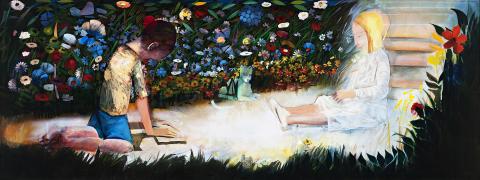THE GARDEN, 1972
CHARLES BLACKMAN
oil on canvas
159.0 x 422.5 cm
signed upper right: Charles Blackman
Corporate collection, Sydney, acquired c.1974
This expansive painting by Charles Blackman is directly related to his major diptych White Cat’s Garden in the Afternoon, 1969 (oil on two canvases, 173 x 275 cm, private collection), itself one of three interconnected works depicting a lush, floral hideaway at various times of the day. Gardens and flowers had featured prominently in the artist’s oeuvre since his earliest days, but in these larger canvases Blackman exploited the similar sense of immersion a viewer feels in the presence of Claude Monet’s monumental ‘Waterlilies’ panels at the Musée de l’Orangerie in Paris. The partial genesis of the ‘Garden’ paintings was located in the period when the artist was living in Brisbane in the early 1950s with his future wife Barbara Patterson ‘near the flower farms at Tamborine, and the close proximity to gardens and bouquets … at Mrs Patterson’s home, where the Blackmans were staying and working.’1 Barbara was also a writer and a poem she had published in 1953 contains the lines: ‘Flowers are bold in the sunlight / and the blue skies waving over; / … Small child never returning / where flowers make separate shadows / … with his own old house and a white cat sleeping.’2 This personal significance of gardens for the Blackmans was further magnified by Barbara’s encroaching blindness, meaning that the bright blooms of flowers were amongst the last things she could visually perceive. In turn, the blindness enhanced her sense of smell and the scent of flowers thus took on great importance for them both.
In The Garden, 1972 a boy kneels whilst reading, totally absorbed in the book as a blonde haired girl sits silently next to half-concealed steps leading off to the right. In between lies a white cat, eyes askance, its gaze fixed upon the studious boy. Flowers of rich and varied hue are in abundance. Through these simple elements, Blackman masterfully creates a private domain of solitude and dreams, darkness and light, shot through with vivid colours and shapes, ‘unreal (and) full of tigerswift brightnesses.’3 It is also an image pregnant with mystery, and filled with so much personal symbolism that it is hard not to view The Garden as a subjective self-portrait. The writer Nadine Amadio comments that due to Blackman’s erratic schooling, ‘he literally educated himself by obsessively reading everything in the world of literature and poetry he could find and, in doing so, acquired his own patina of romanticism that is often present in lonely and imaginative children.’4 Likewise it is plausible that the blonde girl is an apparition of Blackman’s daughter Christabel or even a young Barbara, who had appeared earlier in Blue Alice, 1956 – 57 (Queensland Art Gallery, Brisbane) engulfed by a field of flowers as she negotiated the world beyond the looking-glass. The white cat (which Blackman first painted in The Chase in 1952)5 inhabits many of the paintings in the ‘Garden’ series. A wise and all-knowing presence, it becomes ‘a symbol of many things: innocence, a familiar, a night-self visiting secret places.’6
1. Shapcott, T., Focus on Charles Blackman, University of Queensland Press, Brisbane, 1967, p. 37
2. Blackman, B., Child Away, 1953, cited in: Shapcott, T., op. cit., p. 17
3. Dickens, B. and McGregor, K., Charles Blackman, Macmillan, Melbourne, 2010, p. 12
4. Amadio, N., Charles Blackman: the lost domains, Reed, Sydney, 1980, p. 8
5. Illustrated in: Moore, F.St.J, Charles Blackman: Schoolgirls and Angels, National Gallery of Victoria, Melbourne, 1993, p. 34
6. Amadio, N., op. cit., p. 80
ANDREW GAYNOR
